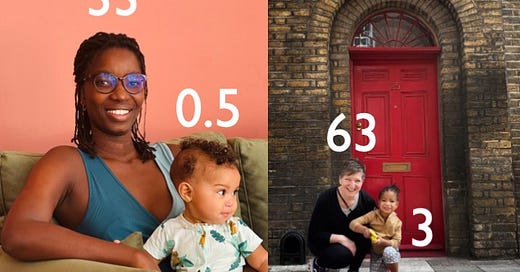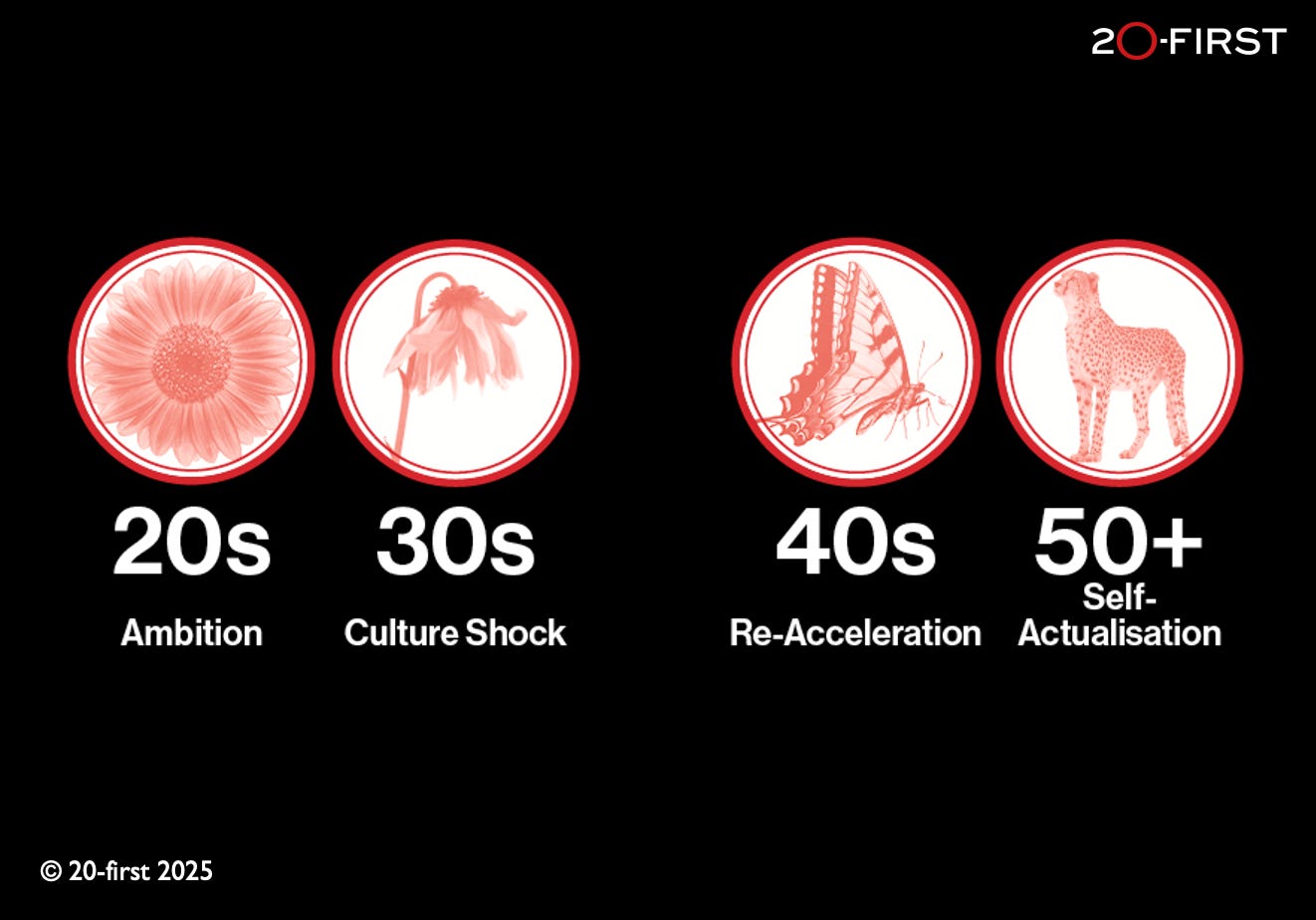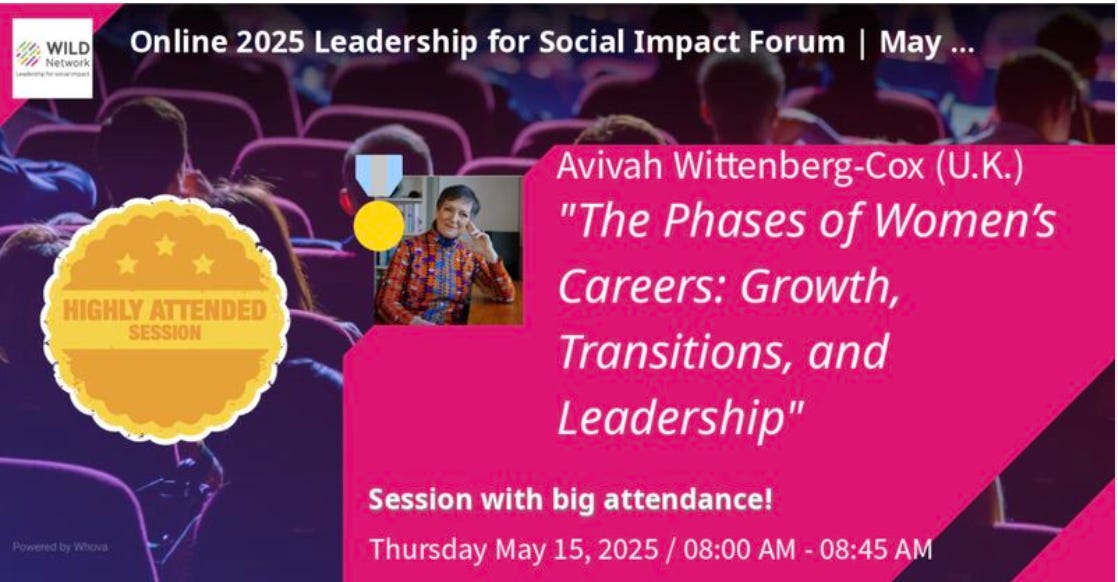My daughter-in-law and I gave a joint presentation to the WILD Network, a leadership development forum for women in social impact and development roles around the world. We wanted to reflect and capture as much of our audience’s diversity as we could. She’s in Dakar, I was in London. She spoke in French, I spoke in English. She’s black, I’m white. She’s Senegalese, I’m a mix of Canadian and French. She’s 33, I’m 63. I thought we covered a fair degree of human variety.
She perfectly mirrored the Q2 phase of life that the majority of our audience was in. Most were in their 30s and 40s, and juggling some of the most challenging decades of women’s lives and roles. I felt a bit like a guide to their future selves. A reminder that after the insanity of Q2, there is this new, substantial phase of life called Q3.
Both Awa’s story and mine serve as pretty archetypal tales of women’s classic career phases. While this doesn’t, of course, represent everyone, I’ve found this picture below resonates with a majority of women in almost every country I’ve traveled to while working on my Q2 topic of gender balance in business (more than 40).
Between us, and judging on the reaction of the more than 300 women who attended the session, it connected.
The Reality of Q2 - The Juggling Act
Awa was a perfect example of the 20s phase of Ambition. A brilliant young French-trained engineer, she started a social enterprise called Lifantou aiming to connect smallholder Senegalese farmers with school canteens using geospatial data and tools. You can read all about it, and her, here. At the same time, her day job was with Senegal’s largest company, telecom operator Sonatel. She worked hard, and passionately, convinced she could change the world with vision and effort, juggling career and impact, family and ambition. She was widely recognised for her efforts with awards and admiration - not so much with investments and contracts.
Her 30s was a classic case of Culture Shock. When the reality of the world and the workplace clash head on with women’s dreams and body clocks. She struggled to get Lifantou financed, then she got married, and had a couple of kids. The choices and tradeoffs begin to take hold. The impossible juggling act between babies and corporate priorities, the inflexibility of systems, the preference for linear, unbroken careers that demonstrate ‘hunger,’ ‘ambition’ and ‘commitment.’ Code words that usually nudge women (and men) who choose to prioritise parenting to the side.
She chose to buck the system and its pressures, and stayed home a couple of extra months (without pay) with her second baby, enabling her to breastfeed and pace her return to when she was getting closer to sleeping through the night. She says that decision made all the difference. Allowing her to return recently to work with delight rather than dismay. Oh yes, and she started another side hustle, a brand called Asali that makes educational cards for kids to teach them about local culture in the local language, Wolof.
Her next phase is likely to be Re-Acceleration. When her kids are tucked into school and her brain and body are freed to reinvest in her endless ideas and career goals. She’s been preparing for that phase with some smart training and upskilling. She’s become an internal coach at Sonatel, working with leadership teams on a range of strategic projects and team dynamics.
The Gift of Q3 - A Whole New Chapter
What women in Q2 rarely hear is that there is this whole other career phase that only starts after 50, what I call Self-Actualisation. So that’s where my story came in. I shared that I had only published my first book, Why Women Mean Business, at age 47, and that it propelled my work on gender issues for a decade, well into my 50s. And that at 60, I went back to school (to Harvard’s Advanced Leadership Initiative) to anchor a whole new chapter focusing on demographics, longevity and generational balance.
The feedback to this sharing is always one of relief. People still believe that careers end early, that you do your best work before 50, and that you’ll be sidelined shortly thereafter. That may have been true in the past, but it’s being transformed by a generation of Q3ers redefining the rules and the game. If they’re prepared. The earlier people people understand the phases, and embrace them, the better able they are to navigate them.
Q2ers, Relax! Q3ers, Lean In!
So the big message for Q2ers, especially parents who choose to have families, is to relax. Not a message they are often told! Life is a lot longer than we think, so pacing for a 60-year career will be different than our old sprints. Rather than dreaming of retiring at 50, why not enjoy a more balanced Q2 and accelerate in Q3? Or negotiate with your parenting partner to take turns at strategic moments that allow you to create a family vision and career, greater than the sum of two individual (and often competing) projects.
It’s almost impossible to imagine your future self. And project yourself into the distant hills of Q3. That’s why it’s important for more of us to share our stories, and to tell the young that they have time. Don’t rush, despair or burnout in Q2. Take your time, learn always, and build slowly towards a broader definition of ‘career’ than what we’ve allowed in the past.
Then in Q3, rather than planning how you might slow down or retire, we’ll be much readier to lean in and gear up. Physically, mentally and perhaps politically. We’re learning how to age in new and different ways. How to eat and exercise. How to build muscle and bone. In parallel, we’ll want to think how to build next chapters and careers, find purpose and passion, re-create and begin again and again.
Undefinable Life Design
I love my colleague’s Charlie Rogers invitation to young Q2ers to imagine portfolio careers in your 20s, not just 60s. That may be where we’re heading. To lives and work that allow time for the different strands of who we are. And instead of having to do them successively over time, we’ll be able to juggle them in parallel. At every age and stage. Especially once AI comes in and starts restructuring work more fundamentally. Charlie calls this ‘undefinable life design.’
“I believe in a world where success isn’t a box we should fit into. It’s a path we create for ourselves. A world where we design our lives to evolve as we do. Where we no longer feel the pressure to be just one thing, but instead embrace the full range of who we are. This is why I created undefinable life design.”
I wrote my book, 4 Phases of Women’s Careers, well over a decade ago. But the patterns and challenges facing women in Q2 seem as present as ever. What’s really changed, and what I had only slightly anticipated, was the emergence of this Q3 phase that would collectively offer a chapter of life that could be more professionally or impact focused for those who had chosen to juggle and prioritise family issues in Q2.
Longer lives, and the relatively short amount of time we will spend caring for kids in a 60-year career, should give parents multiple decades and opportunities to become many things in addition to their parental roles. Of course, there is often an extended time where we need to care for our parents, which still more often falls on women’s shoulders.
But I hope that part of the gift of these extra decades will be to enjoy each of the roles that we choose to assume, in turn. And not feel pressured to hurry through them, or achieve somebody’s definition of ‘success’ at a time not of our choosing. Talent-stretched economies across Europe will be desperate to get women’s labour force participation up. I’m Chairing a big Longevity Conference run by Unicredit in Milan this week where this is a big theme (more on that next week).
May we learn from each other how to prepare and pace ourselves for this new marathon of work and life and love. Our families need us, the world needs us. We mustn’t be forced to choose between them. We need to figure out how to ‘have it all.’ Not just for ourselves, but so that we can contribute for maximum impact. Companies need to support and adapt to the most gender balanced workforce the world has ever had.
Longer lives should gift us the ability to build the three pillars of a life well-lived: someone to love, something to do, and something to hope for.
Now more than ever. Don’t give up. Don’t despair. Get your sneakers on, and get ready for the new marathon.
Reading & Recommended
Geezerhood
A new series from the Free Press, hilariously introduced by 73-year-old Joe Nocera admitting that he’s very bad at getting old and could use some inspiration and role models. This is it.
For gentlemen of a certain age, urology is the midwife of humility.
One Geezer’s Very Old Attack on Harvard
The best analysis I’ve read of why Trump is going after Harvard so assiduously and viciously. It’s an age old story, deeply rooted in American history and a cultural tradition of anti-intellectualism. By the inimitable - and absolutely essential - Heather Cox Richardson.
That history reaches at least as far back as the 1740s, when European-American settlers in the western districts of the colonies complained that men in the eastern districts, who monopolized wealth and political power, were ignoring the needs of westerners. This opposition often took the form of a religious revolt as westerners turned against the carefully reasoned sermons of the deeply educated and politically powerful ministers in the East and followed preachers who claimed their lack of formal education enabled them to speak directly from God’s inspiration.
One hundred years ago tomorrow, that cultural impulse surfaced in a national spectacle that would feed directly into today’s attacks on education.

















What a perfect illustration of intergenerational collaboration and all the benefits and wisdom it brings from both perspectives and for both perspectives. Thank you.
This is very insightful and we'll continue to refer back to it as we're working on our career stories. thank you!